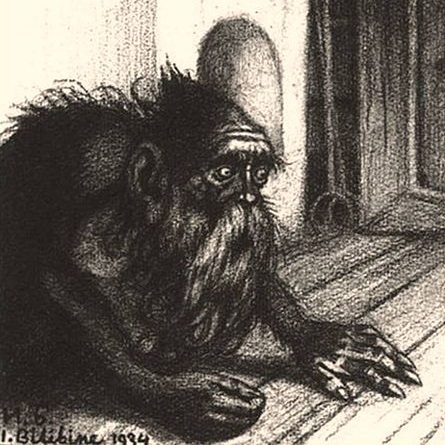
In my book The Spellbinding Secret of Avery Buckle, Avery meets a character called Knuckle. He is broad-shouldered, with hands the size of teapots. He has black freckles clustering his shoulders, arms, and hairline, and every time he sneezes, sparkling embers shoot up into the air. He describes himself as a Hearthfolk, whose job it is to keep the home fires burning.
The idea for Knuckle came from Slavic traditional beliefs about the Domovoi, house spirit-guardians, who usually live under the stove or the hearth. The domovoi are mainly concerned with maintaining order and peace in the home. More often than not, they are heard rather than seen, but when they are seen, they tend to appear as a small, hairy, grey-bearded human. If you’ve read anything I’ve previously written about my more than slight obsession with belonging and home, you’ll not be surprised to learn that I love this idea of a creature who is intent on keeping the home together!
The word ‘hearth’ isn’t apparently related to the word ‘heart’ at all, but in the past hearths really were the heart of the home. This is symbolised in old Dartmoor tradition when moving house. Burning embers from the fire are placed in a tin can and carried from one hearth to the next. In modern homes with central heating it’s hard to imagine how significant the home fire was, but we all know how nice it is to cosy up around the dancing flames of a bonfire or wood burner. Hearths were so important in the past in fact, that in early population censuses, they didn’t count houses, they counted hearths. Even in a medieval peasant’s one-room dwelling there would be a central hearthstone or flat rock, upon which a fire was laid. Then an iron pot with a rounded bottom would be hung over this. Peasants could put in any vegetables that came to hand to make a traditional soup called potage, keeping it on the go from day to day.
Hearths have proved useful in revealing evidence of 10,000-year old meals in the excavation of a Mesolithic house in Northumberland. This house had several hearths in it – shallow depressions filled with charcoal and burnt nutshells. The sheer volume of nutshells in the hearths suggests that this house was used to gather and preserve large quantities of food, probably so it could be kept in to the winter months when food was hard to find. It’s an exciting excavation because it shows that people lived in this house continuously for over 100 years. Previously researchers had thought that people in Britain at this time were always moving from place to place. It’s tricky for us to really understand ancient sites like this, and whether Mesolithic peoples would have called it a ‘home’ in the way that people nowadays tend to think of home as a fixed place. It’s too easy to assume that people in the past thought in the same way as us, especially when you consider how ideas of home have changed even in recorded history. You can read a bit more about that by seeing what Dr Lucy Worlsey has to say about the history of the home HERE
Still, whether the words hearth and heart are connected or not, I do like to think of everyone’s home having a heart. Perhaps you are lucky enough to have a hearthfolk like Knuckle in your home, quietly working away in the background to make it a peaceful and harmonious place. It’s probably worth checking the boiler cupboard now and again, and you just might catch sight of him or her!
You can read more about the excavation of the Mesolithic site called Howick House HERE.






